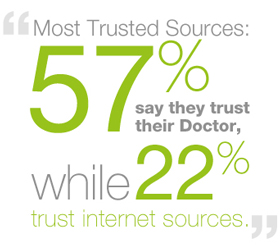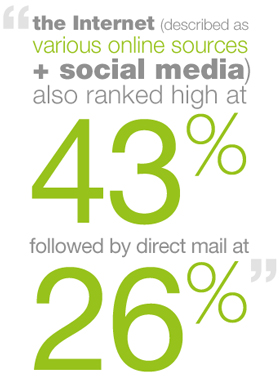Sending Health Information to Hispanics? Choose Your Media Wisely.

The intangible nature of defining a culture and the formation of attitudes that stem from it can be difficult to measure, but we were up for the challenge when we designed our market research study titled, Understanding the DNA of the Mexican Hispanic Consumer: Decoding Attitudes and Beliefs Relating to Health-Seeking Behaviors.
As discussed in previous articles on this topic, our primary goal was to delve into the belief systems that underpin healthcare decision-making in Hispanic audiences, but we also wanted to expand our understanding of the external factors that hold sway in forming those beliefs. One such area, and one that can be a very powerful influencer, is media.
 We felt is was important to dig into media preference because it would help us, as marketers, to zero in on best practices for reaching Hispanic audiences and identify the most trusted source for conveying that information. The results, while decisive, were not predicted.
We felt is was important to dig into media preference because it would help us, as marketers, to zero in on best practices for reaching Hispanic audiences and identify the most trusted source for conveying that information. The results, while decisive, were not predicted.
In our part of the world where we have fluid integration of Mexican and mainstream cultures, we often hear of home remedies and traditional therapies that have been passed down through the generations. So it was surprising for us to learn that family, perhaps your traditional, well-intentioned grandmother, was neither the most-trusted nor most-preferred source for health information. And it wasn’t TV or radio. Do I have your attention?
Our study revealed that the preferred media source for receiving health information for both English and Spanish speakers of all ages was email. A hefty 57% of respondents from the study want to get health information through email. This is not to say you should simply translate all of your content and push it out to every Hispanic surname on your email list… far from it. The first thing you should do is analyze your market, connect with your community and determine the dominant country of origin. Are they mostly of Mexican origin, Central American or Caribbean? Understanding this will give you a big lead on understanding the culture and, therefore, how to approach them with messaging. Remember: lead with culture, then follow with language.
We’ve seen many companies claim that they can identify Spanish-speaking households, but something we’ve also learned in our experience as transcreation specialists is that language usage is incidental and depends on a multitude of factors, such as the topic, who you’re sharing that topic with and (to some extent) where you are when you’re engaged in the conversation (i.e., at home, at school, or perhaps entertaining friends). This aspect of on-the-fly language selection is often referred to as “Code Switching.” We’ve also learned that pushing Spanish-language content to English-speaking individuals simply because they have a Spanish surname can be a big turn off. So unless you have reliable data on language preference, like whether they attended a Spanish-language seminar, do not make this blanket association.
 Marketers beware: this is not a silver bullet. There is both an art and a science to developing outbound campaigns. Compound this with factors like cultural insights and making technical medical language familiar to Spanish-speakers, and things can get complicated very quickly. We never recommend simply translating your campaigns, and that holds true for email campaigns as well. You are sure to miss the mark if you use this technique.
Marketers beware: this is not a silver bullet. There is both an art and a science to developing outbound campaigns. Compound this with factors like cultural insights and making technical medical language familiar to Spanish-speakers, and things can get complicated very quickly. We never recommend simply translating your campaigns, and that holds true for email campaigns as well. You are sure to miss the mark if you use this technique.
So what makes the difference between a wasted budget and successful engagement? It’s often the little things, such as developing captivating subject lines and deciding whether to use text only or rich media in the body of your message. It’s even more important to understand the nuances intrinsic to the culture, like knowing when and how to approach a potentially taboo subject, such as mammography and breast self-exam. Understanding how to broach culturally sensitive topics can make all the difference in getting your message read and acted upon.
If you’re like me, you may be wondering why email is so dominant, especially when we have so many other methods of communication at our disposal. Ask an email marketer and they’d probably say that it provides the user with a measure of control (reading it whenever and wherever they want). Or maybe that it’s more personal because you get a message addressed specifically to you and includes information that you find interesting and relevant. These are ideas that we will explore in depth as we continue to evaluate the communications part of our research.
Either way you look at it, email makes good sense for marketers, too. Using an outbound marketing program can help you gauge interest and engagement, nurture patient relationships and plan long-term conversations with your target. Another thing to keep in mind is that email is a complementary medium and works well when implemented with other methods of outreach, such as TV, radio and outdoor, so don’t discount using these other marketing tools in your campaign.
In case you’re wondering, among Spanish and English speaking research participants of all ages, the Internet (described as various online sources + social media) also ranked high at 43% preference followed by direct mail at 26%. Interestingly enough, direct mail is still a viable non-digital marketing tool for reaching Hispanic audiences.
There is another factor to this email equation that is just as important as media type - the entity (presumably a hospital or healthcare system) or persona that is sending you the message. When it comes to healthcare information, we’ve learned that not all sources are equal when it comes to gaining trust. There is more to come on this important topic in our next article.
In the meantime, if you’d like to receive the initial presentation on the first data extraction from the research, just CLICK HERE and request a complimentary copy. If you’d like to continue to receive articles and insights on our research, please subscribe to our monthly insights using the form on the right.
We will be publishing a series of articles and a final report from the Understanding the DNA of the Mexican Hispanic Consumer: Decoding Attitudes and Beliefs Relating to Health-Seeking Behaviors study in the months to come. If you’re interested in the results and want to see more about the many topics we’ve identified, such as Hispanics and alternative medicine, and identifying the most-trusted sources when conveying medical information, contact Gabe Acuña at (915) 581-7900 or via email at gabe.acuna@culturespanmarketing.com.
Comments